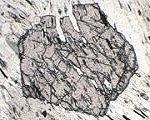Practical Aspects of Mineral Thermobarometry
Estimating rock bulk compositions for pseudosections
From XRF data
One method is to make use of whole-rock geochemical analysis. If your model system is KFMASH and you will have muscovite, quartz and water in excess, you will have to provide a composition in terms of the four components Al2O3, MgO, FeO and K2O. However, you will not be able simply to take the values straight from the bulk analysis. They must be converted to molar proportions and corrected for the A, M, F and K contents of phases outside the model system. The most important corrections will probably be:
- Correcting for the Al contained in plagioclase, which should be equal to the molar amounts of CaO and Na2O.
- Corrections to FeO. The bulk analysis could have had its Fe content expressed in a variety of ways: entirely as FeO, entirely as Fe2O3, or perhaps with some arbitrary percentage expressed as Fe2O3. Probably the best plan is to convert it all to molar FeO and remove any Fe combined in magnetite, haematite, ilmenite, etc. This is an imprecise operation - use petrographic clues. The TiO2 content of the rock may sit in biotite as much as in ilmenite or rutile.
Following the above procedure I estimated the model AMFK ratios of two Bushveld aureole rocks, based on XRF analyses of M33 (Timeball Hill Formation, Annesley), and M37 (Silverton Formation, Burgersfort):
Al2O3 MgO FeO K2O M33 55 10 25 10 M37 42 22 28 8
Warning: Rocks are seldom truly homogeneous. Your probe section, which contains the equilibria you want to model, may not be representative of the different and larger volume crushed for XRF analysis.
From modal data and microprobe analyses
The second method is to estimate the model bulk composition of a rock from the relative proportions of the minerals which fall in the model system, and so define the composition to be modelled. For example, your rock consists of garnet, staurolite, biotite and muscovite with quartz (and perhaps other phases outside KFMASH).
- Estimate modal (volume) proportions from thin sections.
- Use molar volume data (such as those contained in the THERMOCALC data set) to convert to moles (formula units) of each phase.
- For each phase, get the molar amounts of each oxide from the cations per formula unit in your mean microprobe analyses.
- Multiply these by the molar amount of the phase and sum them to give the bulk composition, normalising to 100% if you like.
This approach is commonly more accurate than using the XRF analysis. With M33 above, which contains biotite, staurolite and andalusite, I found that the XRF-derived bulk XMg of 0.286 was more Mg-rich than the biotite (XMg = 0.272), so something was not quite right there, and a better estimate could be obtained from the mineral compositions and mode.
This page last modified 12 October 2004
